Operations, Strategic Management and IS at Tesco: Analysis Report
VerifiedAdded on 2020/10/22
|10
|2713
|328
Report
AI Summary
This report provides a comprehensive analysis of Tesco's operations, strategic management, and the role of information systems. It begins with an introduction to strategic and operations management, setting the context for an examination of Tesco. Task 2 delves into the quality of systems and operations at Tesco and Marks & Spencer, identifying potential improvements. It explores the role of organizational values in strategic planning, analyzing factors that influence effective planning and monitoring. A PESTLE analysis and Porter's Five Forces model are applied to assess the external environment. Stakeholder analysis is conducted to understand their needs and impact on Tesco's strategic position. Task 3 focuses on the contribution of information systems to procurement and supply chain efficiency within Tesco. The report concludes with an overview of the key findings and implications for Tesco's strategic and operational performance.
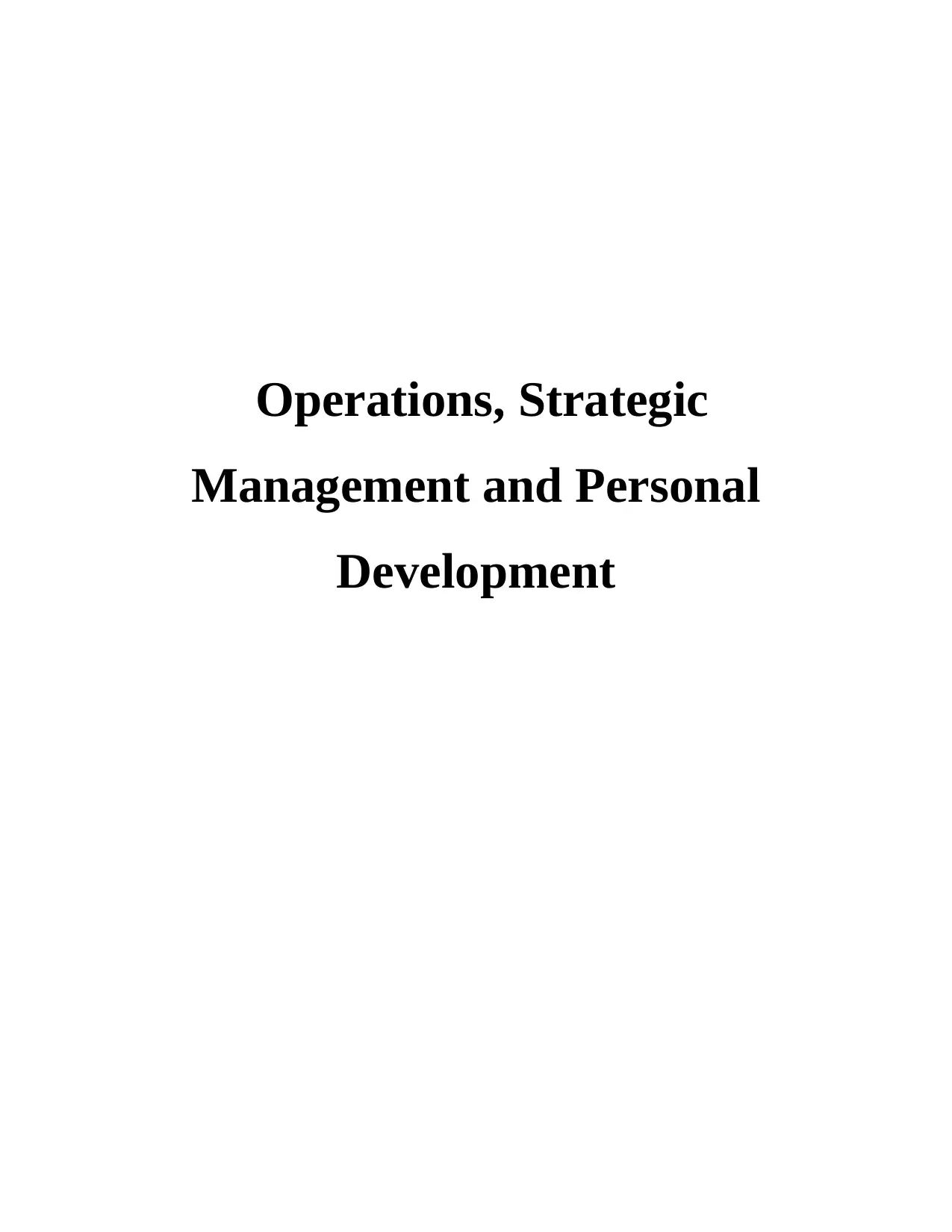
Operations, Strategic
Management and Personal
Development
Management and Personal
Development
Paraphrase This Document
Need a fresh take? Get an instant paraphrase of this document with our AI Paraphraser
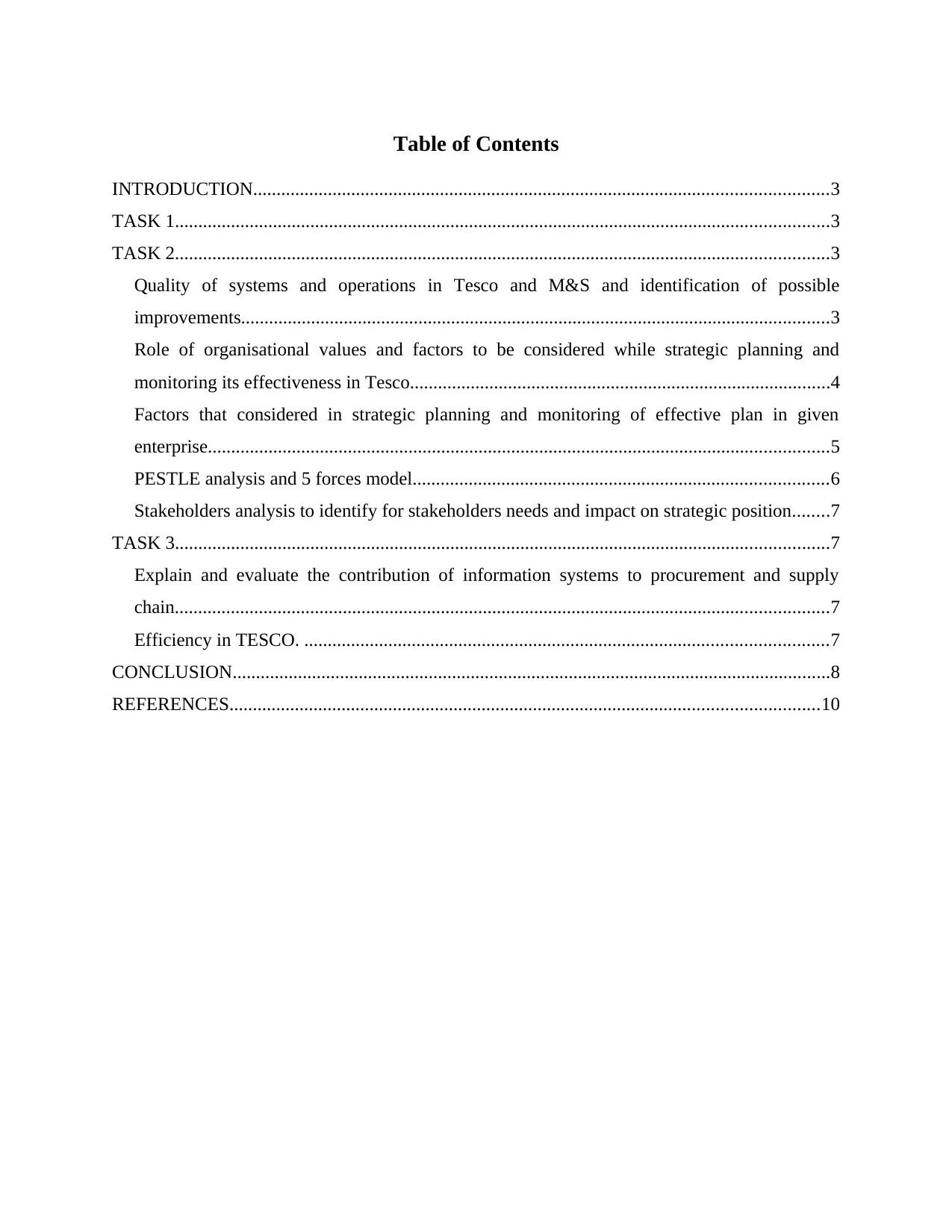
Table of Contents
INTRODUCTION...........................................................................................................................3
TASK 1............................................................................................................................................3
TASK 2............................................................................................................................................3
Quality of systems and operations in Tesco and M&S and identification of possible
improvements..............................................................................................................................3
Role of organisational values and factors to be considered while strategic planning and
monitoring its effectiveness in Tesco..........................................................................................4
Factors that considered in strategic planning and monitoring of effective plan in given
enterprise.....................................................................................................................................5
PESTLE analysis and 5 forces model.........................................................................................6
Stakeholders analysis to identify for stakeholders needs and impact on strategic position........7
TASK 3............................................................................................................................................7
Explain and evaluate the contribution of information systems to procurement and supply
chain............................................................................................................................................7
Efficiency in TESCO. ................................................................................................................7
CONCLUSION................................................................................................................................8
REFERENCES..............................................................................................................................10
INTRODUCTION...........................................................................................................................3
TASK 1............................................................................................................................................3
TASK 2............................................................................................................................................3
Quality of systems and operations in Tesco and M&S and identification of possible
improvements..............................................................................................................................3
Role of organisational values and factors to be considered while strategic planning and
monitoring its effectiveness in Tesco..........................................................................................4
Factors that considered in strategic planning and monitoring of effective plan in given
enterprise.....................................................................................................................................5
PESTLE analysis and 5 forces model.........................................................................................6
Stakeholders analysis to identify for stakeholders needs and impact on strategic position........7
TASK 3............................................................................................................................................7
Explain and evaluate the contribution of information systems to procurement and supply
chain............................................................................................................................................7
Efficiency in TESCO. ................................................................................................................7
CONCLUSION................................................................................................................................8
REFERENCES..............................................................................................................................10
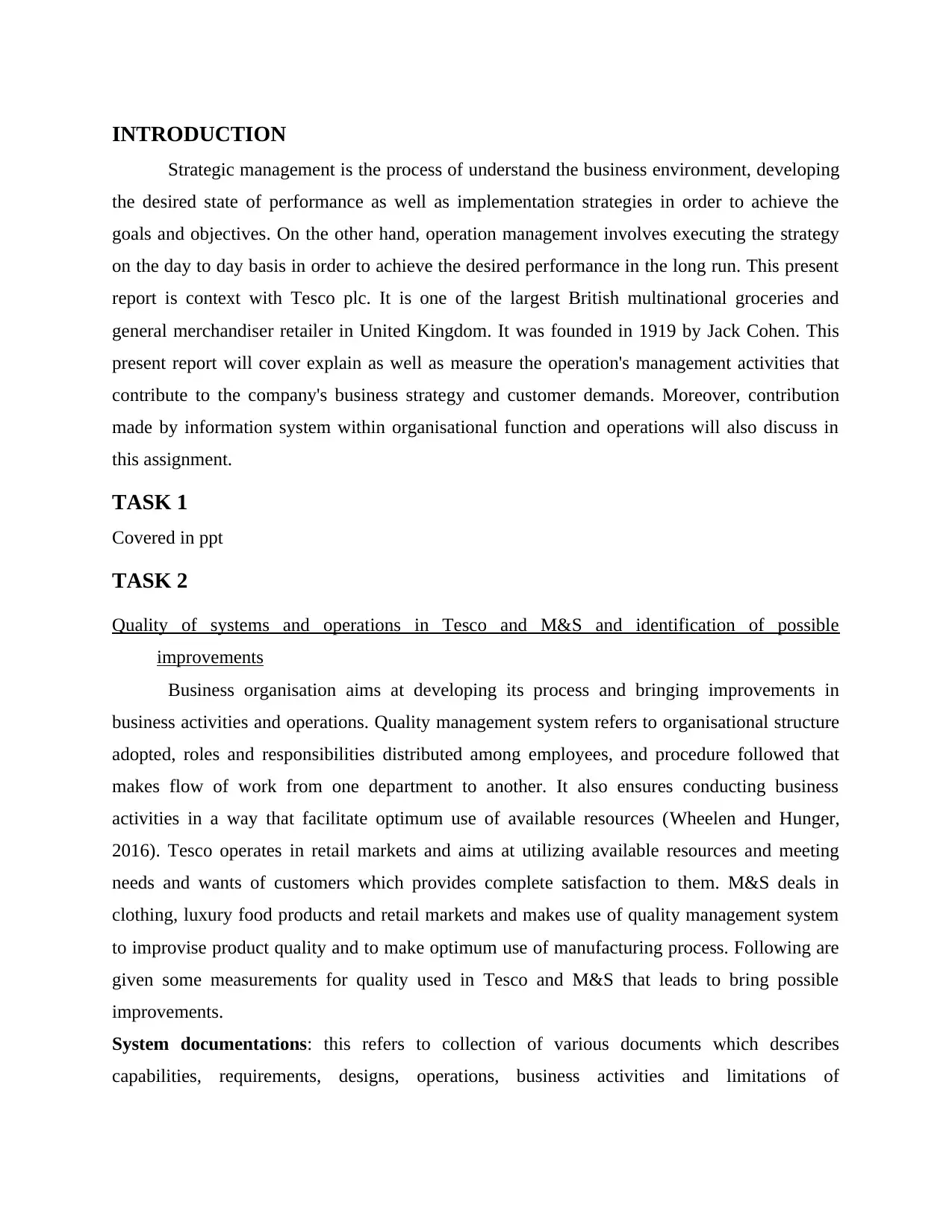
INTRODUCTION
Strategic management is the process of understand the business environment, developing
the desired state of performance as well as implementation strategies in order to achieve the
goals and objectives. On the other hand, operation management involves executing the strategy
on the day to day basis in order to achieve the desired performance in the long run. This present
report is context with Tesco plc. It is one of the largest British multinational groceries and
general merchandiser retailer in United Kingdom. It was founded in 1919 by Jack Cohen. This
present report will cover explain as well as measure the operation's management activities that
contribute to the company's business strategy and customer demands. Moreover, contribution
made by information system within organisational function and operations will also discuss in
this assignment.
TASK 1
Covered in ppt
TASK 2
Quality of systems and operations in Tesco and M&S and identification of possible
improvements
Business organisation aims at developing its process and bringing improvements in
business activities and operations. Quality management system refers to organisational structure
adopted, roles and responsibilities distributed among employees, and procedure followed that
makes flow of work from one department to another. It also ensures conducting business
activities in a way that facilitate optimum use of available resources (Wheelen and Hunger,
2016). Tesco operates in retail markets and aims at utilizing available resources and meeting
needs and wants of customers which provides complete satisfaction to them. M&S deals in
clothing, luxury food products and retail markets and makes use of quality management system
to improvise product quality and to make optimum use of manufacturing process. Following are
given some measurements for quality used in Tesco and M&S that leads to bring possible
improvements.
System documentations: this refers to collection of various documents which describes
capabilities, requirements, designs, operations, business activities and limitations of
Strategic management is the process of understand the business environment, developing
the desired state of performance as well as implementation strategies in order to achieve the
goals and objectives. On the other hand, operation management involves executing the strategy
on the day to day basis in order to achieve the desired performance in the long run. This present
report is context with Tesco plc. It is one of the largest British multinational groceries and
general merchandiser retailer in United Kingdom. It was founded in 1919 by Jack Cohen. This
present report will cover explain as well as measure the operation's management activities that
contribute to the company's business strategy and customer demands. Moreover, contribution
made by information system within organisational function and operations will also discuss in
this assignment.
TASK 1
Covered in ppt
TASK 2
Quality of systems and operations in Tesco and M&S and identification of possible
improvements
Business organisation aims at developing its process and bringing improvements in
business activities and operations. Quality management system refers to organisational structure
adopted, roles and responsibilities distributed among employees, and procedure followed that
makes flow of work from one department to another. It also ensures conducting business
activities in a way that facilitate optimum use of available resources (Wheelen and Hunger,
2016). Tesco operates in retail markets and aims at utilizing available resources and meeting
needs and wants of customers which provides complete satisfaction to them. M&S deals in
clothing, luxury food products and retail markets and makes use of quality management system
to improvise product quality and to make optimum use of manufacturing process. Following are
given some measurements for quality used in Tesco and M&S that leads to bring possible
improvements.
System documentations: this refers to collection of various documents which describes
capabilities, requirements, designs, operations, business activities and limitations of
⊘ This is a preview!⊘
Do you want full access?
Subscribe today to unlock all pages.

Trusted by 1+ million students worldwide
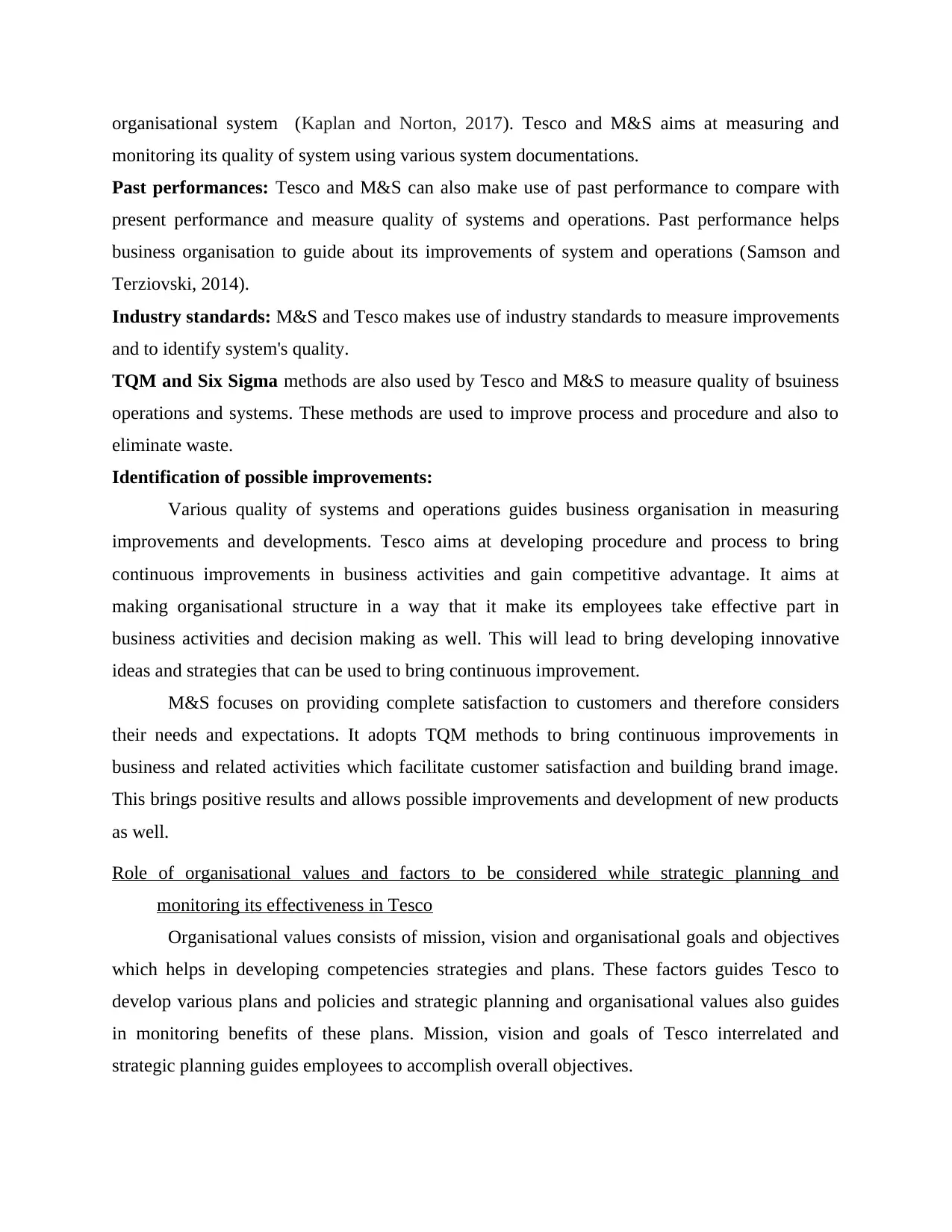
organisational system (Kaplan and Norton, 2017). Tesco and M&S aims at measuring and
monitoring its quality of system using various system documentations.
Past performances: Tesco and M&S can also make use of past performance to compare with
present performance and measure quality of systems and operations. Past performance helps
business organisation to guide about its improvements of system and operations (Samson and
Terziovski, 2014).
Industry standards: M&S and Tesco makes use of industry standards to measure improvements
and to identify system's quality.
TQM and Six Sigma methods are also used by Tesco and M&S to measure quality of bsuiness
operations and systems. These methods are used to improve process and procedure and also to
eliminate waste.
Identification of possible improvements:
Various quality of systems and operations guides business organisation in measuring
improvements and developments. Tesco aims at developing procedure and process to bring
continuous improvements in business activities and gain competitive advantage. It aims at
making organisational structure in a way that it make its employees take effective part in
business activities and decision making as well. This will lead to bring developing innovative
ideas and strategies that can be used to bring continuous improvement.
M&S focuses on providing complete satisfaction to customers and therefore considers
their needs and expectations. It adopts TQM methods to bring continuous improvements in
business and related activities which facilitate customer satisfaction and building brand image.
This brings positive results and allows possible improvements and development of new products
as well.
Role of organisational values and factors to be considered while strategic planning and
monitoring its effectiveness in Tesco
Organisational values consists of mission, vision and organisational goals and objectives
which helps in developing competencies strategies and plans. These factors guides Tesco to
develop various plans and policies and strategic planning and organisational values also guides
in monitoring benefits of these plans. Mission, vision and goals of Tesco interrelated and
strategic planning guides employees to accomplish overall objectives.
monitoring its quality of system using various system documentations.
Past performances: Tesco and M&S can also make use of past performance to compare with
present performance and measure quality of systems and operations. Past performance helps
business organisation to guide about its improvements of system and operations (Samson and
Terziovski, 2014).
Industry standards: M&S and Tesco makes use of industry standards to measure improvements
and to identify system's quality.
TQM and Six Sigma methods are also used by Tesco and M&S to measure quality of bsuiness
operations and systems. These methods are used to improve process and procedure and also to
eliminate waste.
Identification of possible improvements:
Various quality of systems and operations guides business organisation in measuring
improvements and developments. Tesco aims at developing procedure and process to bring
continuous improvements in business activities and gain competitive advantage. It aims at
making organisational structure in a way that it make its employees take effective part in
business activities and decision making as well. This will lead to bring developing innovative
ideas and strategies that can be used to bring continuous improvement.
M&S focuses on providing complete satisfaction to customers and therefore considers
their needs and expectations. It adopts TQM methods to bring continuous improvements in
business and related activities which facilitate customer satisfaction and building brand image.
This brings positive results and allows possible improvements and development of new products
as well.
Role of organisational values and factors to be considered while strategic planning and
monitoring its effectiveness in Tesco
Organisational values consists of mission, vision and organisational goals and objectives
which helps in developing competencies strategies and plans. These factors guides Tesco to
develop various plans and policies and strategic planning and organisational values also guides
in monitoring benefits of these plans. Mission, vision and goals of Tesco interrelated and
strategic planning guides employees to accomplish overall objectives.
Paraphrase This Document
Need a fresh take? Get an instant paraphrase of this document with our AI Paraphraser
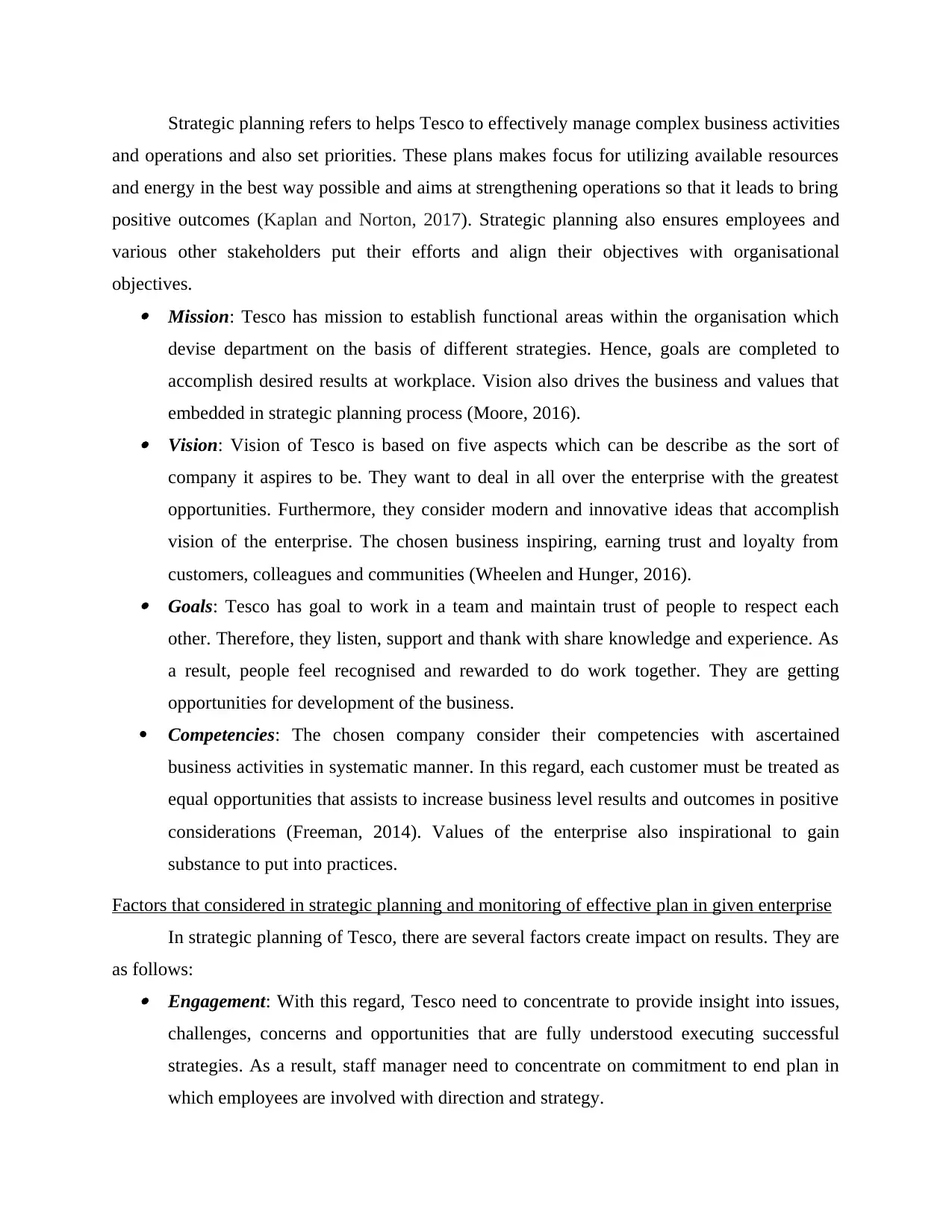
Strategic planning refers to helps Tesco to effectively manage complex business activities
and operations and also set priorities. These plans makes focus for utilizing available resources
and energy in the best way possible and aims at strengthening operations so that it leads to bring
positive outcomes (Kaplan and Norton, 2017). Strategic planning also ensures employees and
various other stakeholders put their efforts and align their objectives with organisational
objectives. Mission: Tesco has mission to establish functional areas within the organisation which
devise department on the basis of different strategies. Hence, goals are completed to
accomplish desired results at workplace. Vision also drives the business and values that
embedded in strategic planning process (Moore, 2016). Vision: Vision of Tesco is based on five aspects which can be describe as the sort of
company it aspires to be. They want to deal in all over the enterprise with the greatest
opportunities. Furthermore, they consider modern and innovative ideas that accomplish
vision of the enterprise. The chosen business inspiring, earning trust and loyalty from
customers, colleagues and communities (Wheelen and Hunger, 2016). Goals: Tesco has goal to work in a team and maintain trust of people to respect each
other. Therefore, they listen, support and thank with share knowledge and experience. As
a result, people feel recognised and rewarded to do work together. They are getting
opportunities for development of the business.
Competencies: The chosen company consider their competencies with ascertained
business activities in systematic manner. In this regard, each customer must be treated as
equal opportunities that assists to increase business level results and outcomes in positive
considerations (Freeman, 2014). Values of the enterprise also inspirational to gain
substance to put into practices.
Factors that considered in strategic planning and monitoring of effective plan in given enterprise
In strategic planning of Tesco, there are several factors create impact on results. They are
as follows: Engagement: With this regard, Tesco need to concentrate to provide insight into issues,
challenges, concerns and opportunities that are fully understood executing successful
strategies. As a result, staff manager need to concentrate on commitment to end plan in
which employees are involved with direction and strategy.
and operations and also set priorities. These plans makes focus for utilizing available resources
and energy in the best way possible and aims at strengthening operations so that it leads to bring
positive outcomes (Kaplan and Norton, 2017). Strategic planning also ensures employees and
various other stakeholders put their efforts and align their objectives with organisational
objectives. Mission: Tesco has mission to establish functional areas within the organisation which
devise department on the basis of different strategies. Hence, goals are completed to
accomplish desired results at workplace. Vision also drives the business and values that
embedded in strategic planning process (Moore, 2016). Vision: Vision of Tesco is based on five aspects which can be describe as the sort of
company it aspires to be. They want to deal in all over the enterprise with the greatest
opportunities. Furthermore, they consider modern and innovative ideas that accomplish
vision of the enterprise. The chosen business inspiring, earning trust and loyalty from
customers, colleagues and communities (Wheelen and Hunger, 2016). Goals: Tesco has goal to work in a team and maintain trust of people to respect each
other. Therefore, they listen, support and thank with share knowledge and experience. As
a result, people feel recognised and rewarded to do work together. They are getting
opportunities for development of the business.
Competencies: The chosen company consider their competencies with ascertained
business activities in systematic manner. In this regard, each customer must be treated as
equal opportunities that assists to increase business level results and outcomes in positive
considerations (Freeman, 2014). Values of the enterprise also inspirational to gain
substance to put into practices.
Factors that considered in strategic planning and monitoring of effective plan in given enterprise
In strategic planning of Tesco, there are several factors create impact on results. They are
as follows: Engagement: With this regard, Tesco need to concentrate to provide insight into issues,
challenges, concerns and opportunities that are fully understood executing successful
strategies. As a result, staff manager need to concentrate on commitment to end plan in
which employees are involved with direction and strategy.
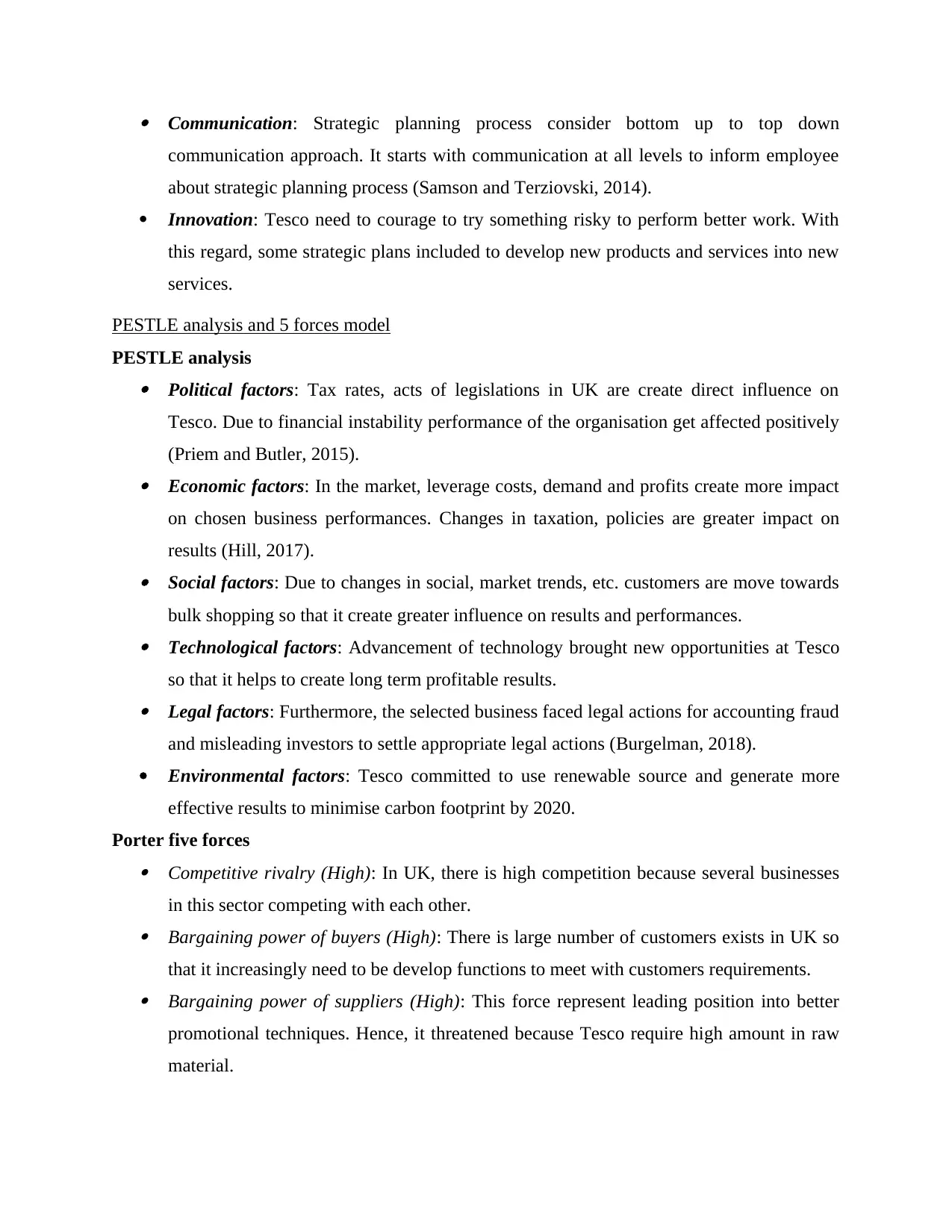
Communication: Strategic planning process consider bottom up to top down
communication approach. It starts with communication at all levels to inform employee
about strategic planning process (Samson and Terziovski, 2014).
Innovation: Tesco need to courage to try something risky to perform better work. With
this regard, some strategic plans included to develop new products and services into new
services.
PESTLE analysis and 5 forces model
PESTLE analysis Political factors: Tax rates, acts of legislations in UK are create direct influence on
Tesco. Due to financial instability performance of the organisation get affected positively
(Priem and Butler, 2015). Economic factors: In the market, leverage costs, demand and profits create more impact
on chosen business performances. Changes in taxation, policies are greater impact on
results (Hill, 2017). Social factors: Due to changes in social, market trends, etc. customers are move towards
bulk shopping so that it create greater influence on results and performances. Technological factors: Advancement of technology brought new opportunities at Tesco
so that it helps to create long term profitable results. Legal factors: Furthermore, the selected business faced legal actions for accounting fraud
and misleading investors to settle appropriate legal actions (Burgelman, 2018).
Environmental factors: Tesco committed to use renewable source and generate more
effective results to minimise carbon footprint by 2020.
Porter five forces Competitive rivalry (High): In UK, there is high competition because several businesses
in this sector competing with each other. Bargaining power of buyers (High): There is large number of customers exists in UK so
that it increasingly need to be develop functions to meet with customers requirements. Bargaining power of suppliers (High): This force represent leading position into better
promotional techniques. Hence, it threatened because Tesco require high amount in raw
material.
communication approach. It starts with communication at all levels to inform employee
about strategic planning process (Samson and Terziovski, 2014).
Innovation: Tesco need to courage to try something risky to perform better work. With
this regard, some strategic plans included to develop new products and services into new
services.
PESTLE analysis and 5 forces model
PESTLE analysis Political factors: Tax rates, acts of legislations in UK are create direct influence on
Tesco. Due to financial instability performance of the organisation get affected positively
(Priem and Butler, 2015). Economic factors: In the market, leverage costs, demand and profits create more impact
on chosen business performances. Changes in taxation, policies are greater impact on
results (Hill, 2017). Social factors: Due to changes in social, market trends, etc. customers are move towards
bulk shopping so that it create greater influence on results and performances. Technological factors: Advancement of technology brought new opportunities at Tesco
so that it helps to create long term profitable results. Legal factors: Furthermore, the selected business faced legal actions for accounting fraud
and misleading investors to settle appropriate legal actions (Burgelman, 2018).
Environmental factors: Tesco committed to use renewable source and generate more
effective results to minimise carbon footprint by 2020.
Porter five forces Competitive rivalry (High): In UK, there is high competition because several businesses
in this sector competing with each other. Bargaining power of buyers (High): There is large number of customers exists in UK so
that it increasingly need to be develop functions to meet with customers requirements. Bargaining power of suppliers (High): This force represent leading position into better
promotional techniques. Hence, it threatened because Tesco require high amount in raw
material.
⊘ This is a preview!⊘
Do you want full access?
Subscribe today to unlock all pages.

Trusted by 1+ million students worldwide
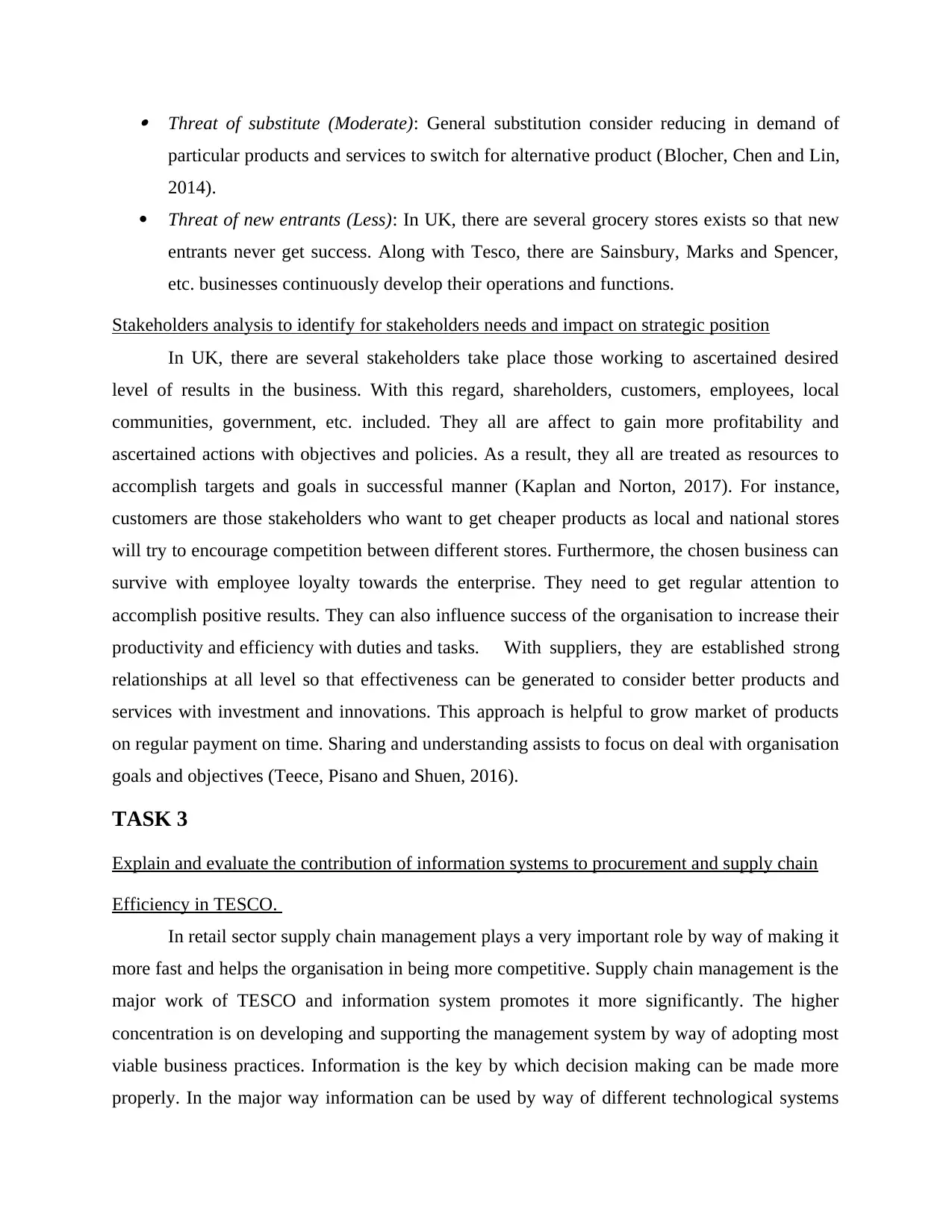
Threat of substitute (Moderate): General substitution consider reducing in demand of
particular products and services to switch for alternative product (Blocher, Chen and Lin,
2014).
Threat of new entrants (Less): In UK, there are several grocery stores exists so that new
entrants never get success. Along with Tesco, there are Sainsbury, Marks and Spencer,
etc. businesses continuously develop their operations and functions.
Stakeholders analysis to identify for stakeholders needs and impact on strategic position
In UK, there are several stakeholders take place those working to ascertained desired
level of results in the business. With this regard, shareholders, customers, employees, local
communities, government, etc. included. They all are affect to gain more profitability and
ascertained actions with objectives and policies. As a result, they all are treated as resources to
accomplish targets and goals in successful manner (Kaplan and Norton, 2017). For instance,
customers are those stakeholders who want to get cheaper products as local and national stores
will try to encourage competition between different stores. Furthermore, the chosen business can
survive with employee loyalty towards the enterprise. They need to get regular attention to
accomplish positive results. They can also influence success of the organisation to increase their
productivity and efficiency with duties and tasks. With suppliers, they are established strong
relationships at all level so that effectiveness can be generated to consider better products and
services with investment and innovations. This approach is helpful to grow market of products
on regular payment on time. Sharing and understanding assists to focus on deal with organisation
goals and objectives (Teece, Pisano and Shuen, 2016).
TASK 3
Explain and evaluate the contribution of information systems to procurement and supply chain
Efficiency in TESCO.
In retail sector supply chain management plays a very important role by way of making it
more fast and helps the organisation in being more competitive. Supply chain management is the
major work of TESCO and information system promotes it more significantly. The higher
concentration is on developing and supporting the management system by way of adopting most
viable business practices. Information is the key by which decision making can be made more
properly. In the major way information can be used by way of different technological systems
particular products and services to switch for alternative product (Blocher, Chen and Lin,
2014).
Threat of new entrants (Less): In UK, there are several grocery stores exists so that new
entrants never get success. Along with Tesco, there are Sainsbury, Marks and Spencer,
etc. businesses continuously develop their operations and functions.
Stakeholders analysis to identify for stakeholders needs and impact on strategic position
In UK, there are several stakeholders take place those working to ascertained desired
level of results in the business. With this regard, shareholders, customers, employees, local
communities, government, etc. included. They all are affect to gain more profitability and
ascertained actions with objectives and policies. As a result, they all are treated as resources to
accomplish targets and goals in successful manner (Kaplan and Norton, 2017). For instance,
customers are those stakeholders who want to get cheaper products as local and national stores
will try to encourage competition between different stores. Furthermore, the chosen business can
survive with employee loyalty towards the enterprise. They need to get regular attention to
accomplish positive results. They can also influence success of the organisation to increase their
productivity and efficiency with duties and tasks. With suppliers, they are established strong
relationships at all level so that effectiveness can be generated to consider better products and
services with investment and innovations. This approach is helpful to grow market of products
on regular payment on time. Sharing and understanding assists to focus on deal with organisation
goals and objectives (Teece, Pisano and Shuen, 2016).
TASK 3
Explain and evaluate the contribution of information systems to procurement and supply chain
Efficiency in TESCO.
In retail sector supply chain management plays a very important role by way of making it
more fast and helps the organisation in being more competitive. Supply chain management is the
major work of TESCO and information system promotes it more significantly. The higher
concentration is on developing and supporting the management system by way of adopting most
viable business practices. Information is the key by which decision making can be made more
properly. In the major way information can be used by way of different technological systems
Paraphrase This Document
Need a fresh take? Get an instant paraphrase of this document with our AI Paraphraser
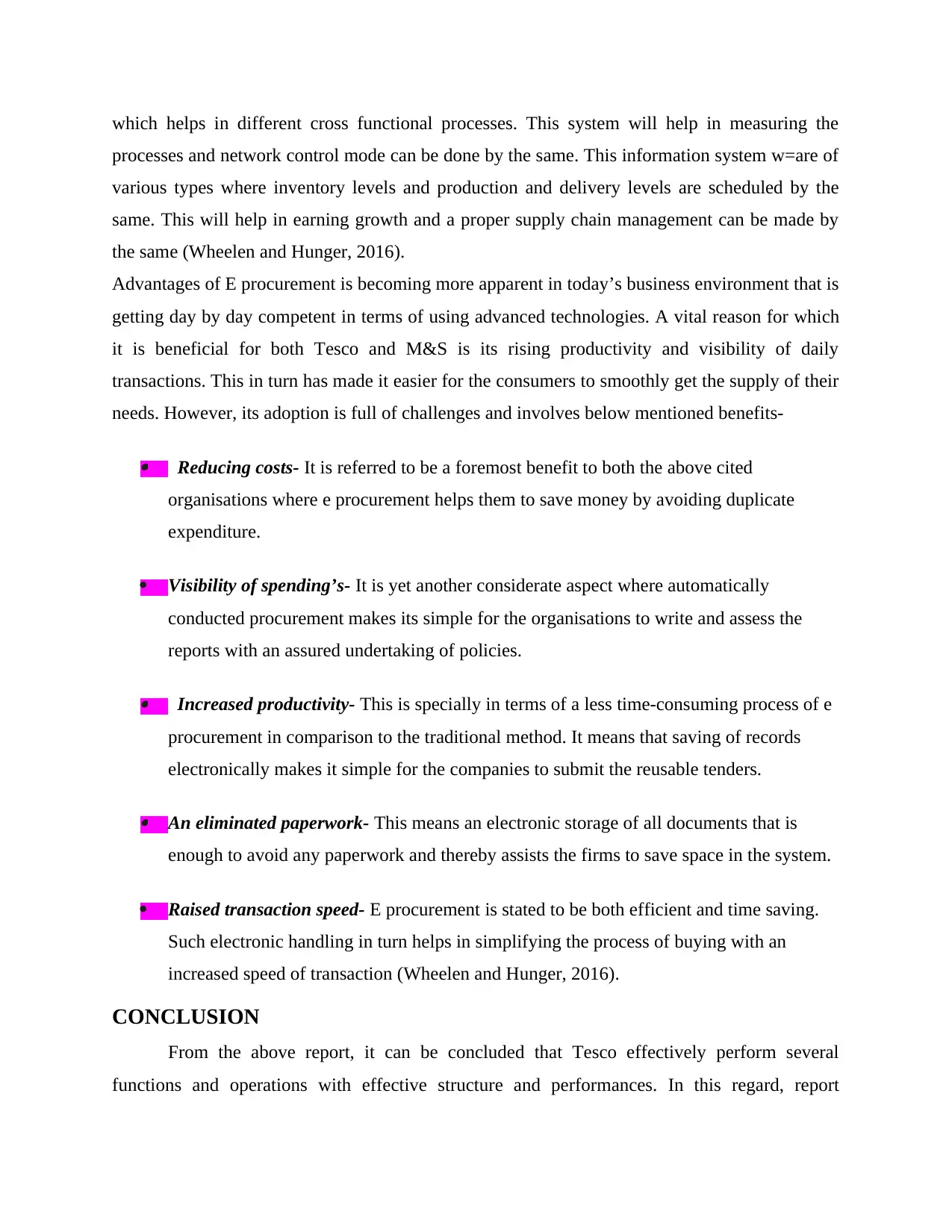
which helps in different cross functional processes. This system will help in measuring the
processes and network control mode can be done by the same. This information system w=are of
various types where inventory levels and production and delivery levels are scheduled by the
same. This will help in earning growth and a proper supply chain management can be made by
the same (Wheelen and Hunger, 2016).
Advantages of E procurement is becoming more apparent in today’s business environment that is
getting day by day competent in terms of using advanced technologies. A vital reason for which
it is beneficial for both Tesco and M&S is its rising productivity and visibility of daily
transactions. This in turn has made it easier for the consumers to smoothly get the supply of their
needs. However, its adoption is full of challenges and involves below mentioned benefits-
Reducing costs- It is referred to be a foremost benefit to both the above cited
organisations where e procurement helps them to save money by avoiding duplicate
expenditure.
Visibility of spending’s- It is yet another considerate aspect where automatically
conducted procurement makes its simple for the organisations to write and assess the
reports with an assured undertaking of policies.
Increased productivity- This is specially in terms of a less time-consuming process of e
procurement in comparison to the traditional method. It means that saving of records
electronically makes it simple for the companies to submit the reusable tenders.
An eliminated paperwork- This means an electronic storage of all documents that is
enough to avoid any paperwork and thereby assists the firms to save space in the system.
Raised transaction speed- E procurement is stated to be both efficient and time saving.
Such electronic handling in turn helps in simplifying the process of buying with an
increased speed of transaction (Wheelen and Hunger, 2016).
CONCLUSION
From the above report, it can be concluded that Tesco effectively perform several
functions and operations with effective structure and performances. In this regard, report
processes and network control mode can be done by the same. This information system w=are of
various types where inventory levels and production and delivery levels are scheduled by the
same. This will help in earning growth and a proper supply chain management can be made by
the same (Wheelen and Hunger, 2016).
Advantages of E procurement is becoming more apparent in today’s business environment that is
getting day by day competent in terms of using advanced technologies. A vital reason for which
it is beneficial for both Tesco and M&S is its rising productivity and visibility of daily
transactions. This in turn has made it easier for the consumers to smoothly get the supply of their
needs. However, its adoption is full of challenges and involves below mentioned benefits-
Reducing costs- It is referred to be a foremost benefit to both the above cited
organisations where e procurement helps them to save money by avoiding duplicate
expenditure.
Visibility of spending’s- It is yet another considerate aspect where automatically
conducted procurement makes its simple for the organisations to write and assess the
reports with an assured undertaking of policies.
Increased productivity- This is specially in terms of a less time-consuming process of e
procurement in comparison to the traditional method. It means that saving of records
electronically makes it simple for the companies to submit the reusable tenders.
An eliminated paperwork- This means an electronic storage of all documents that is
enough to avoid any paperwork and thereby assists the firms to save space in the system.
Raised transaction speed- E procurement is stated to be both efficient and time saving.
Such electronic handling in turn helps in simplifying the process of buying with an
increased speed of transaction (Wheelen and Hunger, 2016).
CONCLUSION
From the above report, it can be concluded that Tesco effectively perform several
functions and operations with effective structure and performances. In this regard, report
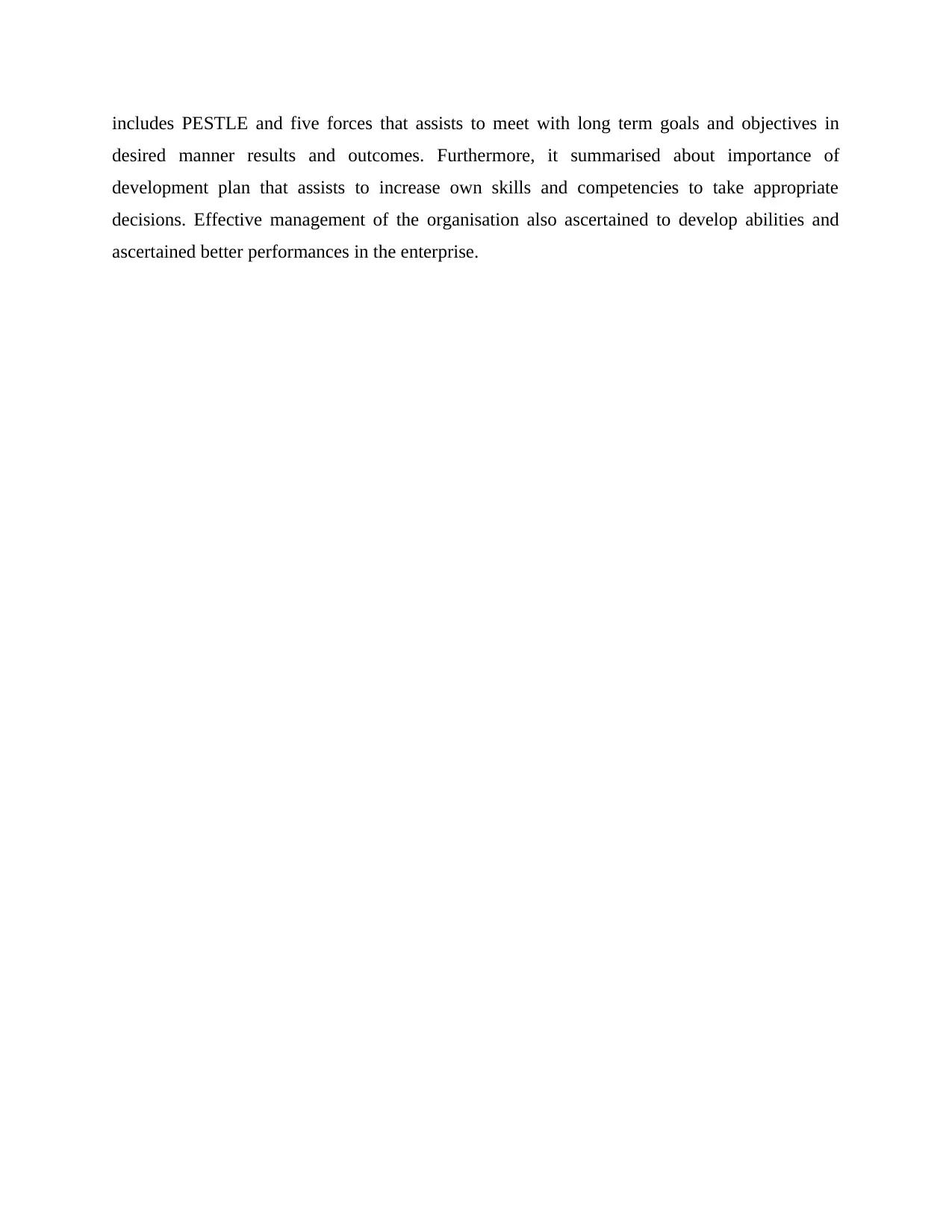
includes PESTLE and five forces that assists to meet with long term goals and objectives in
desired manner results and outcomes. Furthermore, it summarised about importance of
development plan that assists to increase own skills and competencies to take appropriate
decisions. Effective management of the organisation also ascertained to develop abilities and
ascertained better performances in the enterprise.
desired manner results and outcomes. Furthermore, it summarised about importance of
development plan that assists to increase own skills and competencies to take appropriate
decisions. Effective management of the organisation also ascertained to develop abilities and
ascertained better performances in the enterprise.
⊘ This is a preview!⊘
Do you want full access?
Subscribe today to unlock all pages.

Trusted by 1+ million students worldwide
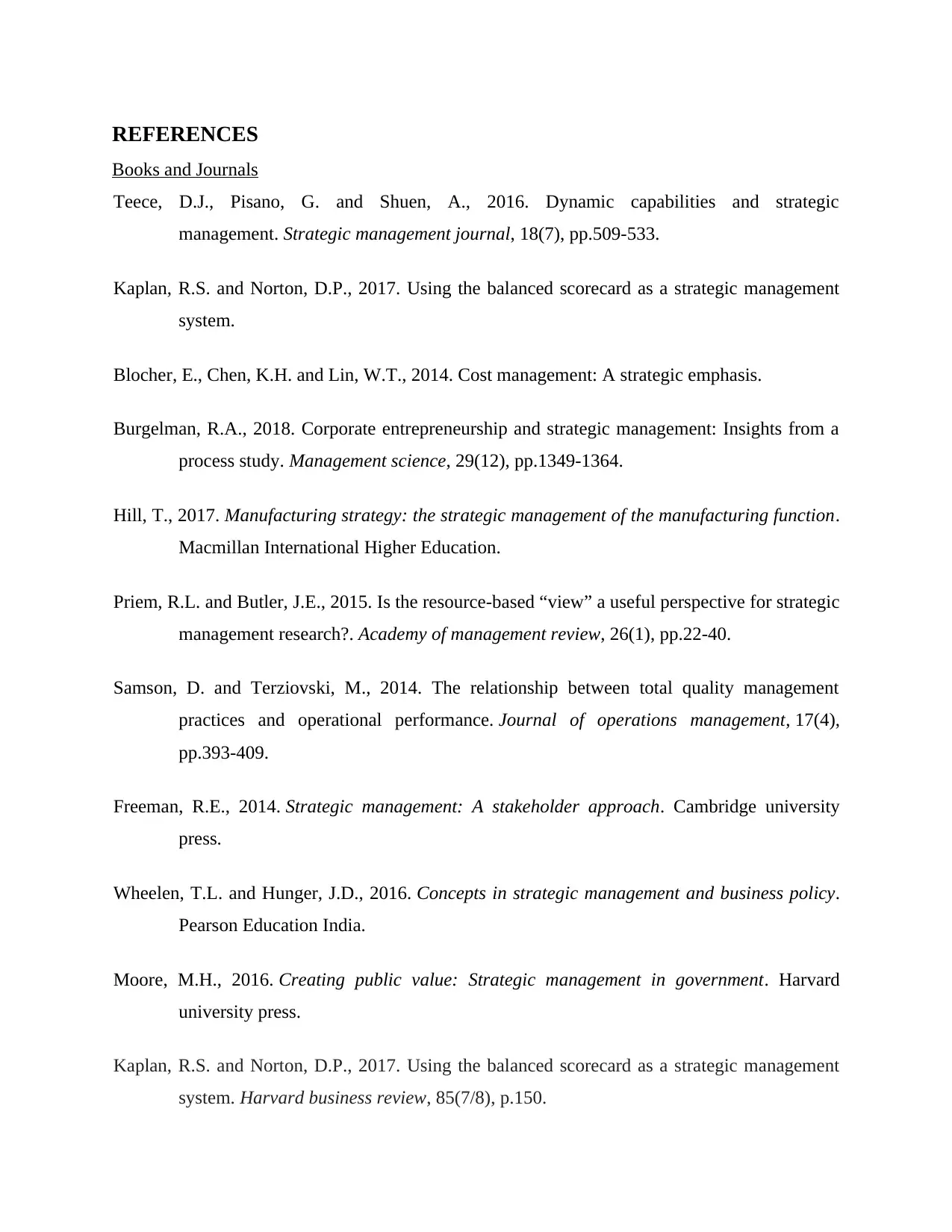
REFERENCES
Books and Journals
Teece, D.J., Pisano, G. and Shuen, A., 2016. Dynamic capabilities and strategic
management. Strategic management journal, 18(7), pp.509-533.
Kaplan, R.S. and Norton, D.P., 2017. Using the balanced scorecard as a strategic management
system.
Blocher, E., Chen, K.H. and Lin, W.T., 2014. Cost management: A strategic emphasis.
Burgelman, R.A., 2018. Corporate entrepreneurship and strategic management: Insights from a
process study. Management science, 29(12), pp.1349-1364.
Hill, T., 2017. Manufacturing strategy: the strategic management of the manufacturing function.
Macmillan International Higher Education.
Priem, R.L. and Butler, J.E., 2015. Is the resource-based “view” a useful perspective for strategic
management research?. Academy of management review, 26(1), pp.22-40.
Samson, D. and Terziovski, M., 2014. The relationship between total quality management
practices and operational performance. Journal of operations management, 17(4),
pp.393-409.
Freeman, R.E., 2014. Strategic management: A stakeholder approach. Cambridge university
press.
Wheelen, T.L. and Hunger, J.D., 2016. Concepts in strategic management and business policy.
Pearson Education India.
Moore, M.H., 2016. Creating public value: Strategic management in government. Harvard
university press.
Kaplan, R.S. and Norton, D.P., 2017. Using the balanced scorecard as a strategic management
system. Harvard business review, 85(7/8), p.150.
Books and Journals
Teece, D.J., Pisano, G. and Shuen, A., 2016. Dynamic capabilities and strategic
management. Strategic management journal, 18(7), pp.509-533.
Kaplan, R.S. and Norton, D.P., 2017. Using the balanced scorecard as a strategic management
system.
Blocher, E., Chen, K.H. and Lin, W.T., 2014. Cost management: A strategic emphasis.
Burgelman, R.A., 2018. Corporate entrepreneurship and strategic management: Insights from a
process study. Management science, 29(12), pp.1349-1364.
Hill, T., 2017. Manufacturing strategy: the strategic management of the manufacturing function.
Macmillan International Higher Education.
Priem, R.L. and Butler, J.E., 2015. Is the resource-based “view” a useful perspective for strategic
management research?. Academy of management review, 26(1), pp.22-40.
Samson, D. and Terziovski, M., 2014. The relationship between total quality management
practices and operational performance. Journal of operations management, 17(4),
pp.393-409.
Freeman, R.E., 2014. Strategic management: A stakeholder approach. Cambridge university
press.
Wheelen, T.L. and Hunger, J.D., 2016. Concepts in strategic management and business policy.
Pearson Education India.
Moore, M.H., 2016. Creating public value: Strategic management in government. Harvard
university press.
Kaplan, R.S. and Norton, D.P., 2017. Using the balanced scorecard as a strategic management
system. Harvard business review, 85(7/8), p.150.
1 out of 10
Related Documents
Your All-in-One AI-Powered Toolkit for Academic Success.
+13062052269
info@desklib.com
Available 24*7 on WhatsApp / Email
![[object Object]](/_next/static/media/star-bottom.7253800d.svg)
Unlock your academic potential
Copyright © 2020–2025 A2Z Services. All Rights Reserved. Developed and managed by ZUCOL.





